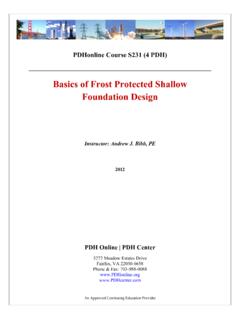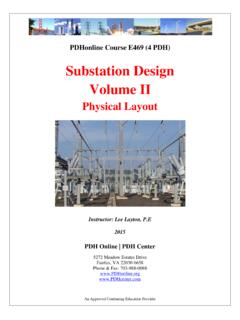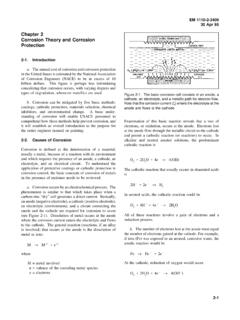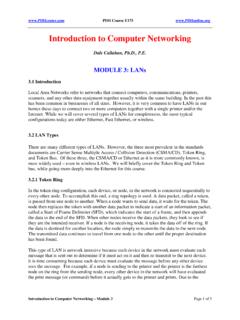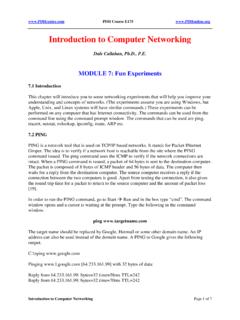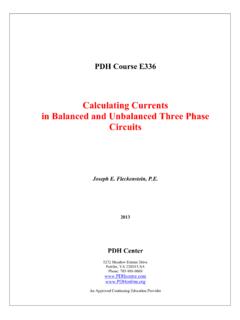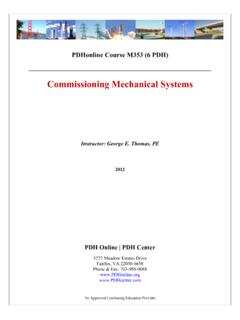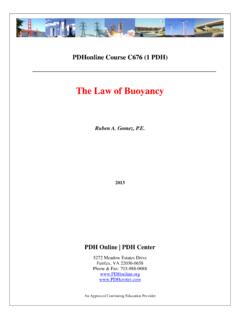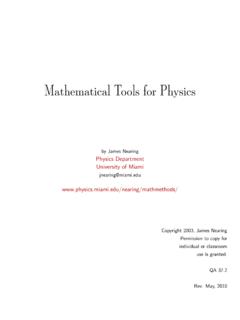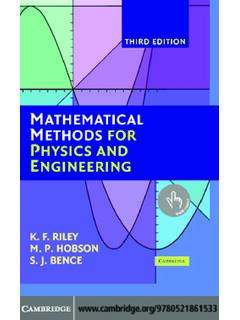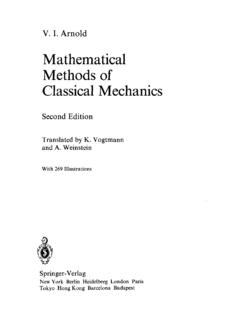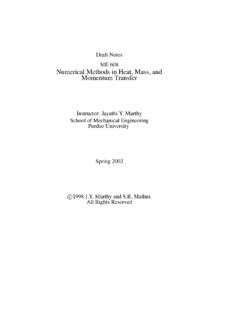Transcription of Fundamentals of Finite Element Methods
1 PDHonline Course S272 (4 PDH) Fundamentals of Finite Element Methods Instructor: Helen Chen, , PE 2016 PDH Online | PDH Center 5272 Meadow Estates Drive Fairfax, VA 22030-6658 Phone: 703-988-0088 An Approved Continuing Education Provide PDH Course S272 Page 1 of 17 Fundamentals of Finite Element Methods Helen Chen, , PE Course Outline Finite Element Method is a powerful engineering analysis tool, and has been widely used in engineering since it was introduced in the 1950s. This course presents the basic theory and simple application of Finite Element Method (FEM) along with common FEM terminology. The emphasis of this course is on the fundamental concepts of Finite Element analysis.
2 A list of major commercial software using FEM is also presented in the course, along with their features and capabilities. This course includes a multiple-choice quiz at the end, which is designed to enhance the understanding of course materials. Learning Objectives At the conclusion of this course, the student will: 1. Understand the concept of Finite Element Method (FEM); 2. Recognize the important role played by FEM in today's engineering world; 3. Understand the matrix operations used in FEM; 4. Get familiar with the different types of Finite elements ; 5. Get familiar with the terminology used in FEM; and 6. Be able to use solve simple structural problems using FEM. Course Content In this course, there are many hypertext links to related information.
3 The reader is encouraged to visit the content within these links to get familiar with the linked subject for better understanding of the course content. What Are Finite Element Method (FEM) and Finite Element Analysis (FEA)? Many engineering phenomena can be expressed by "governing equations" and "boundary conditions". The governing equations are often in the form of partial differential equations (PDE) or ordinary differential equations (ODE). From mathematical standpoint, Finite Element Method (FEM) is a numerical method used for solving a set of related differential equations such as From engineering standpoint, Finite Element Method (FEM) is a numerical method for solving a set of related equations by approximating continuous field variables as a set of field variables at discrete points (nodes).
4 For structural problems, the related equations are equilibrium equations, and the field variables are nodal displacements and loads. PDH Course S272 Page 2 of 17 Finite Element solutions are achieved by either eliminating the differential equation completely (steady state problems), or rendering the PDE into an equivalent ordinary differential equation, which is then solved using standard techniques such as Finite differences. Use of Finite Element Method in engineering to analyze physical systems is commonly known as Finite Element analysis (FEA). Why Use FEM? Many engineering problems have complicated geometry and boundary conditions, which makes it impossible to come up with a closed-form solution.
5 Therefore, numerical Methods such as Finite Element Method, Finite Strip Method, Finite Difference Method, Finite Volume Method, Boundary Element Method and Hybrid BE-FE Method were introduced to provide approximate solutions to complicated engineering problems through the use of a computer. Among the above-mentioned numerical Methods , Finite Element Method is the most powerful and most popular, and often forms the core of many commercially available engineering analysis programs. Because FEM can be adapted to problems of great complexity and unusual geometry using grid or mesh, it is an extremely powerful tool for solving critical problems in heat transfer, fluid mechanics, electrostatics, and structural and mechanical systems.
6 Furthermore, the availability of fast and inexpensive computers allows engineers and architects to solve daily engineering problems in a straightforward manner using Finite Element Method. Common Finite Element Terminology Domain - In mathematics, a domain is the set of independent variables for which a function is defined. In Finite Element analysis, a domain is a continuous system (region) over which the laws of physics govern. In structural engineering , a domain could be a beam or a complete building frame. In mechanical engineering , a domain could be a piece of machine parts or a thermal field. Governing Equations - The governing equations for a system are the equations derived from the physics of the system.
7 Many engineering systems can be described by governing equations, which determine the system's characteristics and behaviors. Boundary Conditions The boundary conditions of a function are values of the function at the edge of the range of some of its variables. Knowledge of some of the boundary conditions is needed to solve an engineering problem or to find an unknown function. Element An Element is a portion of the problem domain, and is typically some simple shape like a triangle or quadrilateral in 2D, or tetrahedron or rectangular solid in 3D. Node - A node is a point in the domain, and is often the vertex of several elements . A node is also called a nodal point. Mesh (Grid) - The elements and nodes, together, form a mesh (grid), which is the central data structure in FEA.
8 Mesh Generation Most FEA software automatically generates refined grid or mesh to achieve more accurate results. For large scale or complex Finite Element analysis, it is often imperative for computers to generate Finite Element mesh automatically. There are many different algorithms for automatic mesh generation. Click here to see some automatically generated mesh samples. PDH Course S272 Page 3 of 17 Linear Finite Element Analysis (FEA) Linear Finite Element Analysis is based on the following assumptions: (1) Static; (2) Small displacements; (3) Material is linearly elastic. Nonlinear Finite Element Analysis Nonlinear Finite Element Analysis considers material nonlinearity and/or geometric nonlinearity of an engineering system.
9 Geometric nonlinear analysis is also called large deformation analysis. GUI GUI stands for graphical user interface, which provides a visual tool to build a Finite Element model for a domain with complex geometry and boundary conditions. Figure 1 shows an example of discretization of a surface domain using triangular elements . The actual boundary of the domain is shown in dashed lines. E1 and N1 represent Element 1 and Node 1, respectively. What Are Matrices and Vectors? To understand Finite Element Methods , one needs to understand the mathematical terms "matrix" and "vector". In mathematics, a matrix is a rectangular table of data. A matrix with m rows and n columns is said to be an m-by-n matrix.
10 For example, 432321211561 is a 3-by-4 matrix. A matrix with m rows and m columns is called an m-by-m square matrix. The simplest matrix is called identity matrix, which is a square matrix with a value of 1 along its diagonal entries and a value of 0 for all other entries. The following matrix is a 3-by-3 identity matrix: 100010001 Figure 1 Triangulation of a Surface Domain PDH Course S272 Page 4 of 17 In the context of Finite Element Methods , vectors are commonly denoted by matrices with dimensions n 1 (column vector) or 1 n (row vector). For example, the matrix below is also called a column vector: Matrices and vectors offer concise mathematical expression for a set of simultaneous algebraic equations.
